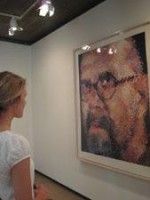Close Up on Close

Visiting the Picker Art Gallery has always been an interesting escape, but with the addition of Chuck Close’s work, the gallery has become an even greater and varied experience. The new additions bring more color and numerous interesting techniques to the Picker for all to appreciate, enjoy and learn from.
On Thursday, September 20, around Chuck Close’s exhibition entitled Self Portrait/Scribble/Etching Portfolio, Bill Hall, a Master Printer at Pace Editions Ink in New York City, spoke to a crowd in the Picker about the work that goes into creating prints such as Chuck Close’s.
With a myriad of colors from all over the spectrum Close captures the likenesses of friends, family and other artists. Close is sometimes called the “Mayor of Soho.”
“[Close is] the only artist who has made a career of painting other artists,” Hall joked.
Close has taken advantage of many different printmaking techniques throughout the years, experimenting and pushing the boundaries of the art. Some of the works displayed illustrate the methods of spitbite, woodblock and scribble/etching. Close constantly reuses faces for his prints, but due to his constant re-invention and experimentation with color and technique the same images never look alike.
“The artist is as much about the process as he is about the finished piece. It makes you appreciate the art not only for its beauty, but also for the steps it took to produce such a piece,” said Picker monitor Beth Pfenning.
This art is also about collaboration. The artist will create the image or form and then break it down into smaller blocks so that the print makers, such as Hall, can apply the correct colors to the correct areas using their respective techniques.
Print Masters work on a piece for months and, sometimes, years on end with an artist. Print making is all about layering and experimenting with processes to create a finished product that is to the standards of the artist himself. This at times requires the artist to give up some control during the process, although they do check and recheck every color and shade.
Close has worked in these many mediums and has adapted his work over the years, calling on art history learned at Yale and life experience to shape his now signature work.
Close’s scribble/etching “heads” displayed at the Picker are the focal point of the display. To create these prints, Hall and his peers set up twelve individual plates on which Close would imprint one of twelve colors at a time to create his own self-portrait. After Close finished with all the plates, the Print Masters experimented with how to layer them upon one another to create the finished product to his satisfaction.
“Chuck spent 10 hours in the studio, that was his effort, we spent two years,” said Hall of the self-portrait.
The largest of the paintings displayed though, is a self-portrait woodcut piece that catches the immediate attention of all who enter the Picker Gallery.
From afar, the painting is viewed as a very vibrant and colorful rendition of Close’s face, but as you near it the individual colors jump out at the viewer and swim together.
The entire exhibition is enhanced by plaques that explain and illustrate the many processes that so interest Close himself and that have created the surrounding pieces. The entire experience of the Chuck Close exhibit is one that is not only aesthetically pleasing, but also a learning experience for all.






